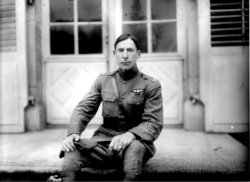
 |
|
|
||
|
Frank Purdy Lahm |
||||
|
Engagements: • World War I (1914 - 1918) |
||||
| Biography: | ||||
|
Frank Purdy Lahm Frank Purdy Lahm was born on 17 November 1877 in Mansfield, OH. He was a grandson of Samuel Lahm, an Ohio Congressman. As a young adult, he developed an interest in flying from his father, who was a balloonist. His mother died unexpectedly when he was very young and his father, who was in poor health, relocated to Europe on the advice of his doctors in order to improve his condition, leaving him and his older sister in the care of relatives. After graduating from high school in 1893, his father brought him to France, where he attended Albert-le-Grand, a Dominican school near Paris. After returning to the U.S. in 1895, he spent two years at the Michigan Military Academy in preparation for the U.S. Military Academy, which he entered in 1897. He excelled at sports and graduated in 1901, in the top fifth of his class. He was commissioned as a Second Lieutenant in the 6th Cavalry, serving in the Philippines for two years. In 1903, he returned to West Point as an Instructor in Modern Languages and spent his summer leaves in France with his father who taught him to fly balloons. In 1907, the Army assigned him to its new Aeronautical Division, the U.S. Signal Corps. In that same year he was introduced to Orville and Wilbur Wright, forming a friendship that lasted until they died. He soon learned that the Army had thwarted the attempts of the Wright Brothers to provide the Army with an airplane, prompting him to write to his superior, Chief Signal Officer Brigadier General James Allen, advocating for favorable consideration to their proposal. The Army finally relented, but the Signal Corps had insufficient funding to accept any of the proposed bids for a powered airplane. However, President Theodore Roosevelt interceded on their behalf and $25,000 in funding was finally secured to accept the Wright Brothers' bid. On 9 September 1908, the Wright Brothers brought their airplane to Fort Myer, VA, for acceptance trials, and on its second flight, Lahm accompanied Orville Wright as a passenger, becoming the first U.S. military officer to fly in a powered airplane, on a flight of six minutes and 24 seconds. In October 1909, he became the Army's first Certified Airplane Pilot. A short time later he returned to his regular branch and joined the 7th Cavalry at Ft. Riley, KS. In June 1910, he attended the Mounted Service School, graduating a year later, and rejoined the 7th Cavalry in the Philippines. At the request of the Signal Corps, he opened a seasonal flying school on the polo ground of Fort William McKinley near Manila on 12 March 1912. After the U.S. entered World War I, he became Commanding Officer of the Army Balloon School at Fort Omaha, NE, in May 1917. He was promoted to temporary Major the following month and, shortly after, was promoted to temporary Lieutenant Colonel and ordered overseas for six weeks to inspect the balloon schools, equipment, and operations in England and France as part of his Air Service duties. Extenuating circumstances caused him to remain in Europe until after the surrender of Germany in November 1918. He returned to the U.S. on 30 June 1919, reverting back to his permanent rank of Captain, and studied at the General Staff College in Washington, DC, for a year. In 1920, the Air Service was made a statutory part of the Army and he applied for a transfer to the new branch. After transferring to the Air Service, he received quick promotions to Major and Lieutenant Colonel and was then assigned to the War Department General Staff. Later, he was Chief of the Organization Branch, Operation and Training Division, and served in that capacity until July 1924. On 2 July 1926, Congress renamed the Air Service to the U.S. Army Air Corps and he was temporarily promoted to Brigadier General on 17 July 1926 to be Commander of the new Air Corps Training Center, established at San Antonio, TX, on 16 August 1926. He quickly realized that because of the small size of his bases, their deteriorating condition, and the encroachment of the city of San Antonio, he needed to find a larger, more permanent location nearby to consolidate all of the Army's flying schools that were located in the general vicinity. A suitable location was finally chosen and he oversaw the design of the model airfield and its construction, which began on 21 November 1928 and was dedicated on 20 June 1930 and named Randolph Field. As a result of his efforts, he is noted by the U.S. Air Force Air Education and Training Command as "the father of Randolph Field." In early 1931, he reverted back to his permanent rank of Lieutenant Colonel until July when he was promoted to full Colonel and assigned as the Assistant Military Attaché at the U.S. Embassy in Paris, France. In 1933 he became the Military Attaché to France, and remained there until 1935. He returned to the U.S. in October as Air Officer, Second Corps Area, Governors Island, NY, until December 1940, when he became Chief of Aviation to the First Army. In September 1941, President Franklin D. Roosevelt awarded him with an honorary promotion to Major General. He served as Commander of the Gulf Coast Air Corps Training Center at Randolph Field, retiring on 20 November 1941 in the grade of Brigadier General,. In 1943, he published a book, "How Our Army Grew Wings." Death Brigadier General Frank Purdy Lahm died on 7 July 1963 in Sandusky, OH. His body was cremated and the ashes spread over Randolph Air Force Base, TX. |
||||
| Honoree ID: 2726 | Created by: MHOH | |||
Ribbons
Medals
Badges
Honoree Photos
 |  |  |
 |  |
 |


